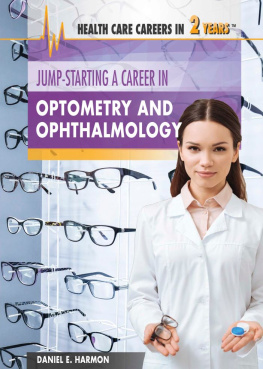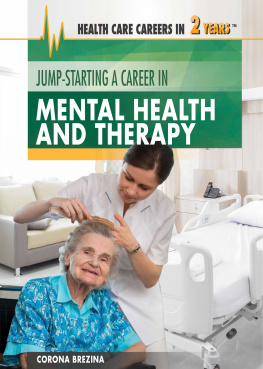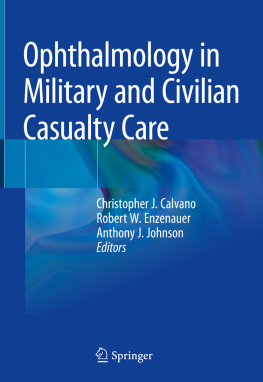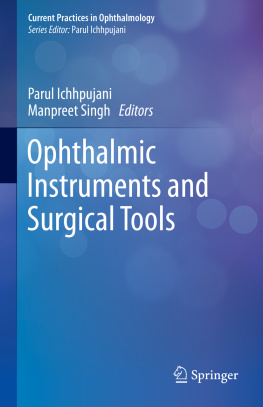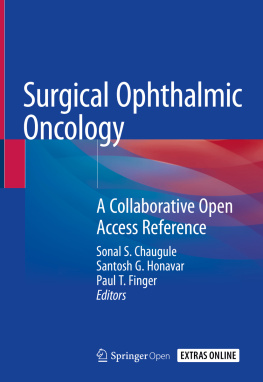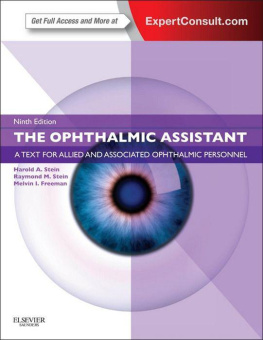Published in 2019 by The Rosen Publishing Group, Inc.
29 East 21st Street, New York, NY 10010
Copyright 2019 by The Rosen Publishing Group, Inc.
First Edition
All rights reserved. No part of this book may be reproduced in any form without permission in writing from the publisher, except by a reviewer.
Library of Congress Cataloging-in-Publication Data
Names: Harmon, Daniel E., author.
Title: Jump-starting a career in optometry and ophthalmology / Daniel E. Harmon.
Description: First edition. | New York : Rosen YA, 2019. | Series: Health care careers in 2 years | Audience: Grades 7-12. | Includes bibliographical references and index.
Identifiers: LCCN 2018010613| ISBN 9781508185055 (library bound) | ISBN 9781508185048 (pbk.)
Subjects: LCSH: OphthalmologistsJuvenile literature. | Optometrists Juvenile literature. | OphthalmologyVocational guidanceJuvenile literature. | OptometryVocational guidanceJuvenile literature. | VisionJuvenile literature.
Classification: LCC RE52 .H37 2019 | DDC 617.7/023dc23 LC record available at https://lccn.loc.gov/2018010613
Manufactured in the United States of America
CHAPTER 1
CARETAKERS OF EYESIGHT
CHAPTER 2
CLINICAL JOBS IN EYE CARE
CHAPTER 3
RUNNING THE PRACTICE
CHAPTER 4
TRAINING AND EDUCATIONAL REQUIREMENTS
CHAPTER 5
FINDING A JOB
CHAPTER 6
OPTIONS AND OPPORTUNITIES
P eople should schedule vision checkups annuallyor more frequently, if they have serious, chronic eye problems. When visiting an optometrist's office, a routine examination by the optometrist and staff is much the same from year to year.
On arriving, the patient signs in at the receptionist's window. The first thing requested is updated contact and insurance information. Has the customer changed residences, phone numbers, or vision policies since the last visit? Regardless, the receptionist or a billing specialist seated nearby probably will ask to make a copy of the insurance card or cards to make sure the patient's office record is up to date.
In typical optometry practices, the patient is then called to the workstation of an optometric technician. The technician applies a chemical solution to the corner of the eyes that will dilate the pupils. Dilation allows the examiner to scrutinize the back of the eyes for signs of trouble. The technician performs a battery of eye tests to determine the quality of the patient's vision. (The most famous test: What is the smallest line the patient can read on the standard eye chart?) During the course of the exam, the technician asks questions to determine whether the patient has been experiencing vision changes or problems.
Dilation is an important step in most optometrists office visits because it allows optometric technicians and optometrists to get a better look inside the patients eyes.
The patient then meets with the optometrist, who may perform similar or additional tests. The optometrist diagnoses any problems; prescribes upgraded lenses, medication, and therapy, if necessary; listens to the patient's concerns; and answers questions. At the end of the visit, the patient knows the current status of her vision 20/20, which is perfect, or a lesser rating as well as any conditions that are affecting her eyesight. If new corrective lenses are needed, the patient will consult with an optician for fitting. Many optometry offices have opticians on staff exhibiting every style of lens and eyeglass frame.
Checking out, the patient makes payment or authorizes an insurance filing. The patient leaves the office with two items: 1) disposable glasses with shaded lenses to relieve discomfort from sunlight until the dilation chemical wears off and 2) an appointment card scheduling the date for the next checkup.
Besides the individuals the patient meets face-to-face in the facility, others are at work behind the scenes. They analyze and process information, maintain electronic records, and assist the optometrist and other staff members in many ways.
Many eye care professionals wear corrective lenses themselves or have eye conditions that require medication or therapy. Some became interested in optometry- or ophthalmology-related careers while in school. Their eye health resulted in repeated trips to the doctor's office and inspired them to ask questions about the peculiar equipment and the procedures going on around them.
A job in the office of an optometrist or ophthalmologist is highly rewarding. Most important, the worker is helping meet critical health needs of patients, many of whom have challenging vision problems. At the same time, the staff person performs interesting tasks in a secure, well-paying employment environment. If the individual wishes to advance in this career sector, many opportunities present themselves.
G ood vision affects how effectively and comfortably people work, read, drive, and interact with others. A challenge is that the condition of the eyes does not remain constant. At one or more stages of life, practically everyone undergoes changes in vision. Many experience problems that can be corrected or managed easily. Others' issues are very serious and can lead to damaged vision or the loss of eyesight entirely. Vision disorders range from detached retinas and cataracts to glaucoma and macular degeneration.
Ophthalmologists and optometrists are the medical professionals who diagnose and treat conditions and diseases of the eyes. With regular eye checkups, they can detect problems in the early stages and treat them before they become more threatening. Early warning signs can include chronic reddening or bulging of the eyes, frequent shedding of tears, loss of side vision, double or distorted vision, or changes under different lighting conditions.

Optometry and ophthalmology offices keep medical files on each patient they treat. Various staff members need to consult these files, so they must be kept up to date and organized well.
These professionals rely on different workers to help them perform their jobs. The American Optometric Association (AOA) reported that as of 2015, the average optometrist employed 4.7 staff members. Support staff include workers with technical and clinical training. A professional practice also requires people trained in office management, clerical duties, insurance processing, and other nonmedical functions.
A SIGHT-IMPAIRED NATION
More than 150 million Americans about half the populationrequire corrective eyewear, according to the American Academy of Ophthalmology (AAO). The AAO reports that Americans spend more than $15 billion annually on vision wear.

